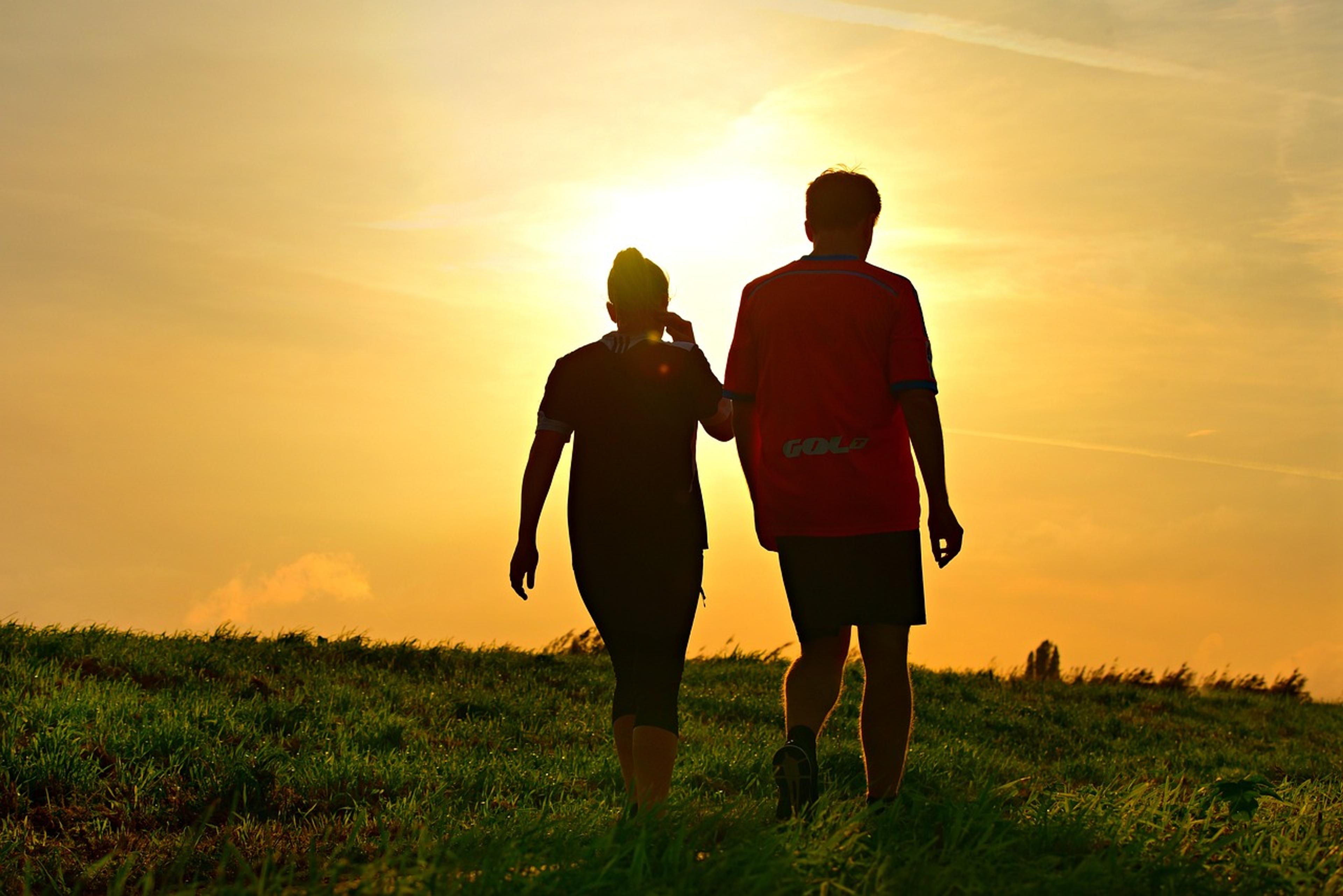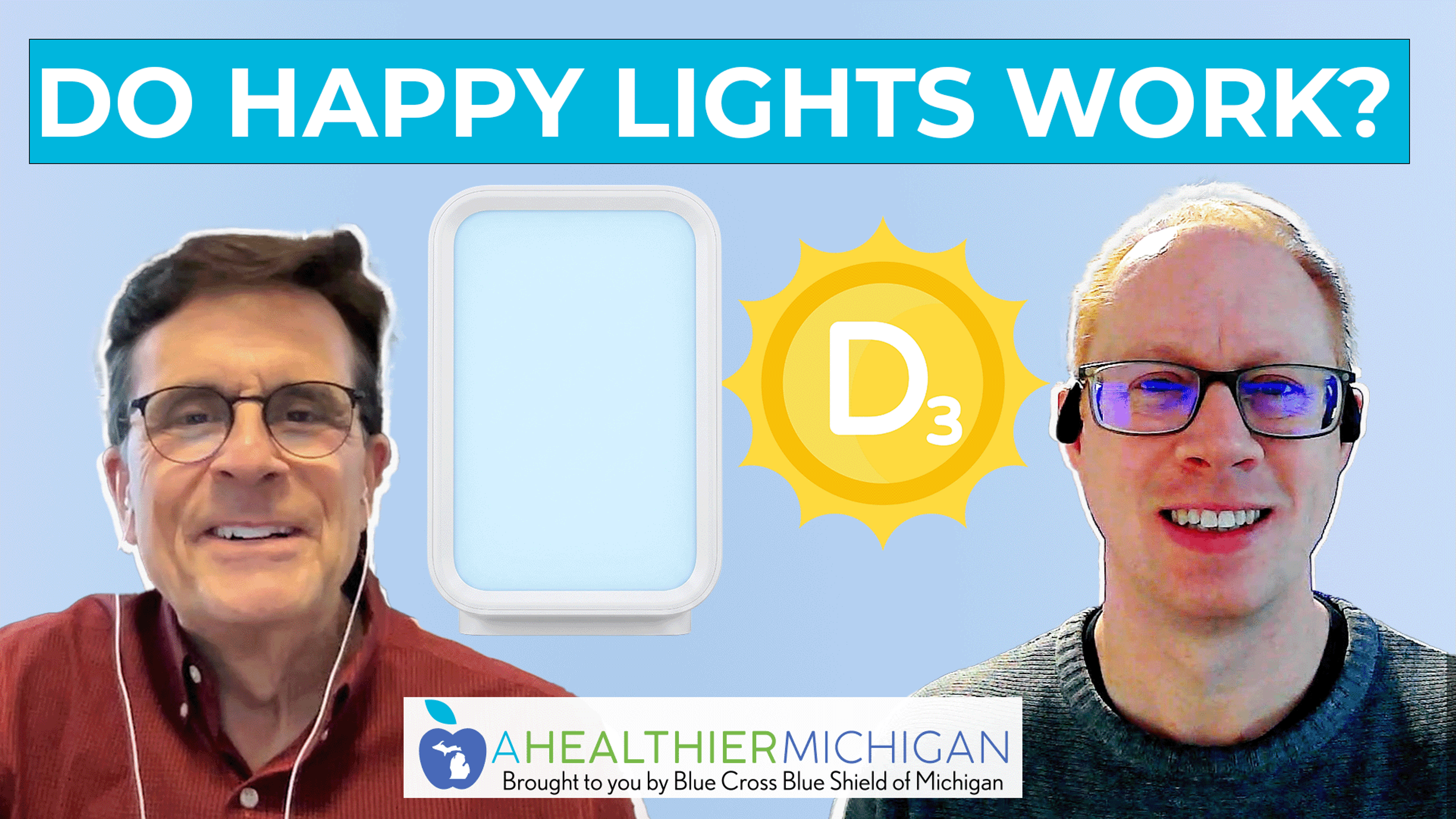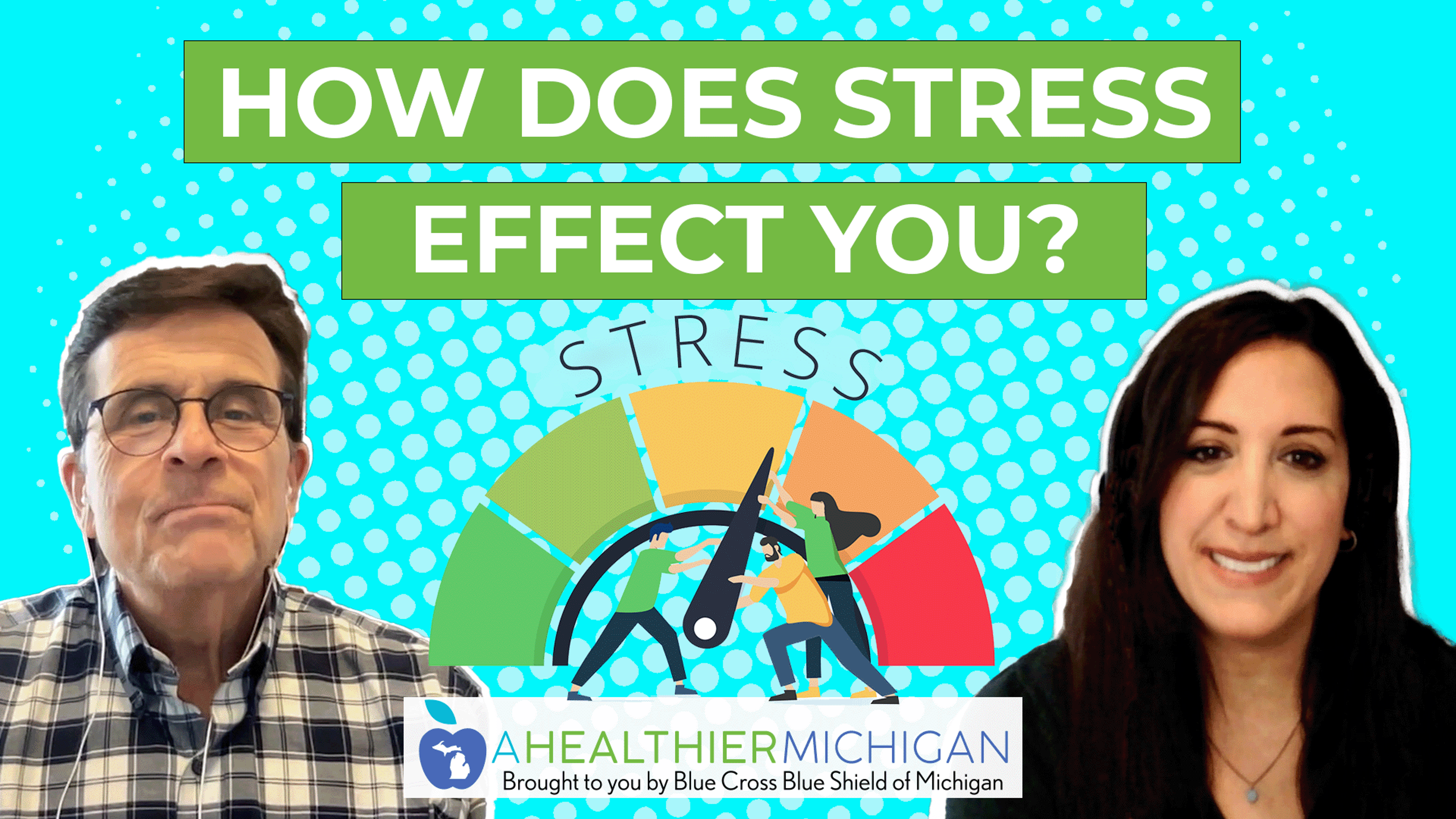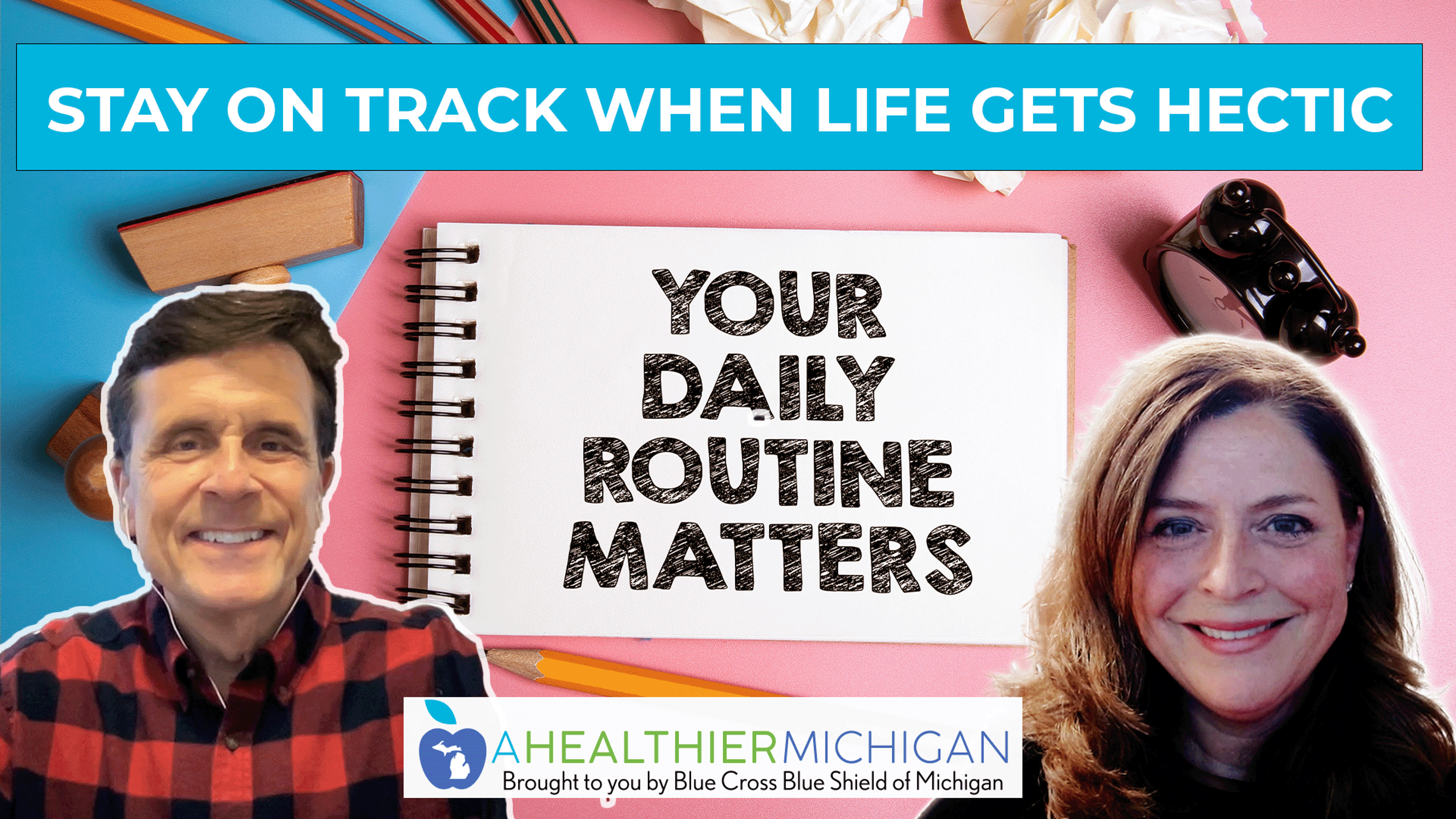Is 10,000 Steps a Day Fact or Myth?
| 1 min read

00:00
00:00
About the Show
On this episode, Chuck Gaidica is joined by Marissa Jarrett, well-being coordinator for Blue Cross Blue Shield of Michigan. Together, they discuss if 10,000 steps a day is the step goal we should be aiming to achieve.
In this episode of A Healthier Michigan Podcast, we explore:
- Where 10,000 steps a day originated
- If 10,000 steps a day is beneficial across the board, or can it vary from person to person
- The benefits of maintaining a step goal
Transcript
Here is the full transcript of this episode. You can listen to the audio version on streaming platforms or watch on YouTube.
Chuck Gaidica:
This is A Healthier Michigan Podcast, episode 142. Coming up, we'll explore if there's any truth to the idea that 10,000 steps a day will improve our mental and physical health.
This is A Healthier Michigan Podcast, episode 142. Coming up, we'll explore if there's any truth to the idea that 10,000 steps a day will improve our mental and physical health.
Welcome to A Healthier Michigan Podcast. It's a podcast that's dedicated to navigating how we can improve our health and wellbeing through small, healthy habits that we can start implementing right now. I'm your host, Chuck Gaidica. And every other week, we sit down with a certified expert and we discuss topics that cover a myriad of items, from nutrition to fitness and a lot more. And on this episode, we're diving deep into maintaining a daily step goal. Are you tracking those steps? Is it 10,000? Is that the number we're all shooting for? Is it something magic that we're looking for in that 10,000? Well, joining us today is Marissa Jarrett, who is a wellbeing coordinator, also co-host for Blue Cross' virtual Wellbeing sessions. It's good to have you back, Marissa.
Marissa Jarrett:
Thank you, Chuck. Happy to be here.
Chuck Gaidica:
Well, I know you live on a farm and I'm picturing your steps are being built running around chasing the chickens, probably not the honeybees. Do you chase a Tibetan yak? What animals are you chasing there to build your steps?
Marissa Jarrett:
Yeah, I tend to stay away from the yaks, but my husband chases them quite often. But we got plenty of things here to make sure I get my steps in.
Chuck Gaidica:
I'll bet you do. This 10,000 number, it's a number that we've heard for a long time from various sources, so it's familiar to a lot of people, especially if you've ever gotten a fitness tracker. I've heard 7,500 was a magic number, then it was 10,000. Over the course of interacting with different experts over time right here on this podcast, we've come to find out that exercise is very individual. Some of us can make up a lot of steps just in our daily activities. We don't really have to focus on going for power walks or something. What makes this 10,000 number jump out? And is there something magic about it?
Marissa Jarrett:
I don't think there's anything magic about it. It actually started as a marketing campaign back ahead of the Tokyo Olympics back in, I think it was 1964. And a pedometer that they had made actually had the name Manpo-Kei, I think. And it stood for the Japanese number 10,000. It looked like an individual walking. That's where it came from.
But yes, you talked about it being in our fitness tractors. I think it just ends up being like a standard of measurement. It is something to aim for healthy adults. When I dove into the research, you are seeing benefits from simply taking 2,000 steps. I've seen it go all the way up to 15,000. Somewhere in there the steps seem to level off and plateau. But looking at some of the research the University of Sydney did, for every 2,000 steps, they found a person could lower their risk of premature death incrementally by 8% to 11% all the way up to 10,000 steps. Now, take into consideration, is it longevity, mortality, risk of chronic disease? What I found in the research was different steps leveled off or improved certain benefits.
Chuck Gaidica:
And what do you mean by different steps? You mean the pace like jogging versus just going for a walk? Or what do you mean?
Marissa Jarrett:
No, different steps that you accumulate throughout the day. For example, for every 2,000 steps, you are lowering your risk of premature death by 8% to 11%. If you walk 3,800 steps a day, you lower your risk of dementia by 25%. Are you looking to lower your risk of dementia? Are you looking to reduce your risk of cardiovascular disease? 7,000 steps a day was linked to premature death, reduced chances of 50% to 70%. 8,000 steps a day lowered your risk by 51% for all cause of mortality. There's a threshold and there's a sweet spot as I dove in deeper to the research that led up to 10,000 steps.
Chuck Gaidica:
Well, it's interesting, just before we went to record today, I saw a headline. To be fair, I've opened the story, but talking about dementia risk and how sitting leads to increased dementia risk. We've seen other stories about sitting is the new smoking. When you look at daily activity, even if it's walking around your house or you're taking a business call, there are ways to fit in steps that sometimes we don't think about, right?
Marissa Jarrett:
Absolutely. It is important. We were built to move. Movement is what gets the blood flowing. It's what sends oxygen up to our brain. Sedentary people may be walking less than 2,700 steps a day can really see improvements in their health if they just add an additional 2,000 steps a day. We may accumulate 5,000 steps just doing normal household activities, doing our chores, doing our grocery shopping. Then if you add another 30 minutes of walking... And it doesn't have to be 30 minutes at a time. We're seeing a lot from the CDC that you can do two, five, 10 minutes. As long as you're working up to a minimum of 30 minutes a day, that equates to about 4,000 stops. Now you're doing your normal chores, you're doing some grocery shopping, you're accumulating 5,000. If you add a 30 minute walk, you're getting another 4,000 steps. You're getting really close to that sweet spot. I've read in the research of 10,000 steps. Like you said, taking little breaks during the day.
Chuck Gaidica:
Well, yeah, and finding ways to do that. Well, and what's nice about those breaks, and I try this myself, is it breaks the monotony. You don't have to say, "Oh, it's another 30 minute walk." Having two dogs, that really helps me because they take me for a walk two to three times a day. I've got those dog walks and I've got general walking around the house, I know that I'm getting four to 6,000 steps a day. And then when I go out purposefully walking with my wife or whatever else I'm doing or by myself, I know I'm approaching that threshold if not exceeding it. Or doing yard work. I don't have a farm, but there were days in the past month that I've gotten up to 18,000 steps goofing around with yard work.
Marissa Jarrett:
It doesn't take a lot, especially when you get in the groove of doing something. And if you don't go out with the mindset that you have to accumulate steps, you'll get lost in the activity, especially if it's something you enjoy doing. And like you said, by the end of the day, you've racked up 18,000 steps. And it's not like you set out to do that, you were just busy spending time with your wife, letting your dogs take you for a walk. Good thing for those dogs, right?
Chuck Gaidica:
Well, they're great for that. And they're both about 50 to 55 pounds, so it's not a joke. The little one that's 50 pounds, she's going to take me for a walk without any questions, so it's all in my favor. Did you see anything in the research you looked into that allows us to give ourselves some grace about the daily steps? In other words, if we look at the whole congregate of the week. Because my watch, which is tied to my phone for steps, will tell me what's happening for the whole week as well and what my averages are. It does give me some grace that if I did have a day where it's pouring rain or snowing or something's going on, well, I know that for the week, man, I'm still averaging 10,000. Good job.
Marissa Jarrett:
Absolutely. And that's a good step count for healthy adults to aim for. But if you're just starting out, maybe you're only going to be accumulating 4,000 to 5,000 steps a day or 7,000 to 8,000 steps a day. You need to consider your activity level. What I read in the research was you don't have to have 10,000 steps every single day. Again, it's something to aim for. But I was seeing the steps even increase. As you look into the research, 15,000 steps a day correlated with a lower risk of metabolic syndrome. Type two diabetes, there was reduction in that. That seemed to be a little bit more when you even picked up your pace at walking.
I think the whole idea really is to just get moving and fit it in wherever you can. If you don't hit 10,000 steps today, that's okay because there's benefits when you just hit... Let's say, for example, you hit 7,000 steps a day. That's been linked to a 50% to 70% reduction in premature death. What is it that you're going for? 8,000 steps was associated with a 51% all cause mortality reduction. And then if you bump that up to 12,000 steps, that had a 65% association with a lower risk for all cause mortality. I don't think we should get stuck on having that 10,000 ingrained in our head because it might be 10,000 today, it might be 7,500 tomorrow, it might be 18,000, 20,000 over the weekend because we tend to be outdoors doing more things with friends and family.
Chuck Gaidica:
Well, you just mentioned the word pace, and I want to come back to this because it was just about a week ago. My wife and I were streaming the series on the blue zones. And two of the places they highlighted where people are living to 100 years and more generally was Sardinia and also Okinawa in Japan. And when I watch those people walking, there's a cultural part of this as well. It's the older gentlemen are walking slowly, often with canes, but to be fair, sometimes uphills, straight uphills, especially in Sardinia. And they're walking with their arms behind their back, and they're chatting with a friend. And it's moseying. And I know for me, I've always thought, man, if I'm not killing my knees and jogging or moving fast, I've got to get it going. Did you see anything in the research? Do you know about the idea of pace? Does it really matter how fast we're doing those 10,000 steps?
Marissa Jarrett:
Again, I think it's a good idea to include brisk walking with regular walking. Of course, longer walks are going to build your endurance. And like you mentioned, they were climbing uphill, which is also going to be building their leg strength. What I found in the research was that brisk walking can substantially reduce a person's risk of developing type two diabetes. There was a study published last year in the Journal of Diabetes Care that determined for every 1,000 steps a person takes, they have a 6% lower risk of developing type two diabetes. I also read that walking at a faster pace was linked to a lower risk for dementia, heart disease and cancer and early death. There is research out there that says walking briskly can have some additional benefits, but it's not something that you need to do all the time. Take a walk, add some brisk walking in every now and then, but then go back to your regular pace.
Chuck Gaidica:
And I'm guessing, I don't want to infer too much out of the research, but just anecdotally, it would seem that if you're a person that's getting 10,000 steps a day, there probably are other healthful things you're involved in. You may be losing some weight because you're in this constant movement pattern, you may be paying more attention to a good diet. It just seems like if you're involved in that mindset, there's the potential that you're also either starting or you already know certain healthful other activities and ways of living that are helpful to keeping you going to 100.
Marissa Jarrett:
Absolutely. You've got that walking regularly that can help with a body fat reduction. If you are coupling that with a healthy eating lifestyle, it lowers your blood pressure. Even just being outside can improve your mood, it can reduce your stress levels. Not to mention, going back to your blue zones comment, it's a social activity, so it allows you to get outside, meet new people, explore your community, maybe explore new communities, if you happen to be vacationing or visiting a friend who lives in a different town than you do. And even changing up your terrain, that can all add up to feelings of even accomplishment, knowing that you've walked longer or you conquered steep inclines or stairs.
Chuck Gaidica:
Yeah. I want to talk to you, if you don't mind, a little bit of the personal stuff because there you are... How many acres? Nine acre farm?
Marissa Jarrett:
Yes.
Chuck Gaidica:
Do you look at these numbers and do you relate to this? Or do you wake up and go, "I get 10,000 steps before 6:00 AM because I'm on a farm"? Personally, what do you see happening, if you track it all, your steps having a farm like that with all the animals?
Marissa Jarrett:
I try not to get hung up on a number. There'll be some days where I'm surprised by the number of steps I take. Especially in the summer, I like to walk up and down our driveway, which is about a quarter mile. And then if I take it to the back of the barn and back, I might get a half a mile in. I can rack up some pretty good steps. But I'm doing so much other stuff on top of that. I'm riding my bike, I'm lifting weights, I'm watching what I'm eating, I'm playing with my grandchildren, I'm walking my dogs. I'm not really getting caught up in the number, I'm just appreciative of the ability that I can move and that I feel good. And walking is an excellent way to increase our bone health. And as we get older, we start to lose that, so it's very important to be out there and having that impact walking for as often as we can.
Chuck Gaidica:
I also am reminded because I've got a friend who's a manager at one of the big box stores, and he told me the number, and I'm not quite sure, but when you walk in the store, if you were to start at the corner where they check your ID when you come in and just go on a diagonal to the other corner of the store, it was a quarter mile, something crazy. And I thought, wow, I know we're all walking those steps to try to buy the apples over here and the chicken salad over there, whatever else you're doing, but purposefully, as we start to approach a season where the weather can change and maybe prohibit some from getting out, using a mall, the old idea of being a mall walker or walking a big box door, we do have opportunities, including our community centers, et cetera. Which leads me to say, not because I want to be pompous about it, but it doesn't give me any excuses to weasel of this idea of trying to move.
Marissa Jarrett:
And Chuck, we don't even have to leave our homes. A lot of people will say, "Oh my gosh, it's raining outside," or it's snowing. My laundry room is in my basement. And I just have a ranch so I don't have an additional set of stairs. But for people who live in a two-story home, if their laundry room is downstairs, I tell people, "When you do your laundry, take one piece up at a time and put it away." It's a good way to start accumulating additional steps in your house. When you're on the phone talking to family and friends, walk around your house. Now we're not tethered to those little curly cords attached to a wall anymore, we have the ability to walk wherever we can. If you have a treadmill or a bike, get lost in a movie. Put on the television. And I did that a couple times during the winter last year. And even recently, in the early mornings, I would just get on my bike, and I'm able to log on to Netflix and stream movies. And I'll spend 90 minutes on my bike as opposed to 20 minutes because I'm engaged in something and I'm not worried about moving on to the next thing.
And even if you want to go outside, just be prepared for the weather. Make sure you've got a good pair of shoes or sturdy boots, hats, gloves. Get outside. And even just five or 10 minutes and the fresh air will really help improve your mood and just help your energy levels.
Chuck Gaidica:
When you said that about... And I know it's true because I do the same thing. If I get on my bike and I'm watching something, even if I'm streaming it on my phone or something, time does evaporate. But I'm reminded of an old... It wasn't a cartoon, it was a meme of connecting a cable to our TVs from our bikes or our treadmills, that if you weren't walking, you couldn't watch it. I know it's not going to happen, but I thought, wow, I can't really be a squirrel or a hamster in a wheel, but that whole idea of just moving while I'm watching, that makes a lot more sense than sitting there and just eating popcorn or something, right?
Marissa Jarrett:
Absolutely. We were built to move. I was talking to some people for one of the webinars we were doing on Celebrating Your Life and Living to 100. And what I liked about it is I think we interviewed six or seven different people over the age of 65 up to almost 100, and they all had the same comment, keep moving. You have to keep moving as little as it is, even if it's just to your mailbox and back. My favorite line was, "If you stop moving, you rust up." You always want to keep moving.
Chuck Gaidica:
Well, the older I get, the more I realize. It's funny you say it that way because I do think of using the stairs to the basement is oiling up the knees. Yeah.
Marissa Jarrett:
Right. Yeah. There's lots of ways that you can get your steps in without having to leave your house; walking back and forth down your hallway, walking up and down your steps. You just want to be mindful of where you're walking and that you have good supportive shoes on. If you're not accustomed to walking 8,000 or 10,000 steps right now, you don't just want to get up and start walking it. You have to build up to that. You have to first appreciate where you are right now. Take into consideration what your abilities is. Talk to your doctor always before starting an exercise program. But start slow. Maybe start adding 500 steps extra a day or 1,000 steps extra a day until you get to that point that you want to be at, whether it's 7,800, 10,000, 12,000, or 15,000.
Chuck Gaidica:
Well, you've given us so many great ideas and takeaways, but as we wrap up, any other takeaways, bullet points you want us to really concentrate on?
Marissa Jarrett:
First, like I said, always check with your doctor before you start an exercise program, even as simple of something as walking. Especially if you're older, you want to make sure there aren't any issues. Pick a fun place to walk. Bring a friend with you. Invest in a really good pair of shoes. Don't get caught up in the number, just do it. Just get outside and move. And don't worry about trying to do 30 minutes of time or 45 minutes of time, take those little... We call them activity breaks or activity snacks. Throw two or three minutes in here or there in between phone calls, in between meetings. If you're at work doing an extra lap, parking further away from the door if you're going out to the grocery store. There's all kinds of ways that you can get in those additional steps. Don't get stuck on 10,000. If you get there, wonderful, but there are still a lot of great benefits at 7,800. I think in the research I read, 7,800 was the threshold where the benefits start to level off a little bit. But again, it depends on what you're going for. Is it mortality? Is it cancer? Is it dementia? Just walk and challenge yourself a little bit to walk a little more each day.
Chuck Gaidica:
Well, you said it right in that whole conversation at the end here. Just do it. I'm going to lock that phrase up. I bet we could make millions with that. What do you think?
Marissa Jarrett:
Yeah, I'm not sure. I think somebody already did.
Chuck Gaidica:
See, I'm always behind the curve. Marissa, it's great to see you. Thanks for all the wisdom.
Marissa Jarrett:
Absolutely. Thank you, Chuck. Have a great day.
Chuck Gaidica:
You too. Marissa Jarrett, who's a wellbeing coordinator and also co-host for Blue Cross' Virtual Wellbeing series. We're glad she was with us. And we're glad you were here. Thanks for listening to A Healthier Michigan Podcast. It's brought to you by Blue Cross Blue Shield of Michigan.
If you like the show, you want to know more, check us out at the newly refreshed, ahealthiermichigan.org/podcast. You can leave us a review or rating on Apple Podcast or Spotify. You can also follow us on Facebook, Instagram, even Twitter. And you get new episodes on your smartphone or tablet, which you can put right in front of you when you're on your treadmill or bike or something. Be sure to subscribe to us on Apple Podcast, Spotify, or your favorite podcast app, and just take us for a walk with you. I'm Chuck Gaidica. Be well.





